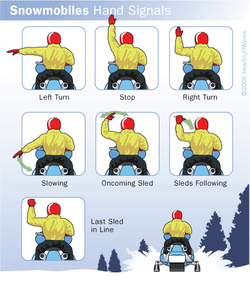Safety
Safety Information
Always be alert of potential danger. Your helmet and engine noise can impair your hearing. Visability is also reduced in conditions of snowfall, blowing snow and night driving. Never assume what another snowmobiler will do. Do all that you can to ensure your safety and that of other riders. Expect the unexpected!
Don't Drink and Ride
Night Riding
A disproportionate number of snowmobiling incidents, including nine out of ten fatalities, occur after dark.
Forward visibility is reduced by darkness and it is much more difficult to spot and identify potential hazards in time. Overdriving headlights can also be a serious problem, so slow down when snowmobiling after dark. Becoming disoriented or lost is much more likely at night. Ride with individuals familiar with the area.
Always wear outer clothing with reflective trim on the arms, back and helmet. Never ride alone at night. Always dress in your full snowmobiling outfit even if your intended destination is just next door.
Be certain that all lights are operational and keep in mind that hand signals become increasingly more difficult to see as darkness sets in.
Dressing Properly
With high tech winter wear and proper layering, winter comfort is easy. Start with polypropylene and thermal under layers that releases moisture while retaining heat. Add other heat retentive layers depending on the temperature. Also consider the fact that your forward motion will add to the wind chill factor. Avoid cottons and sweat shirts which retain moisture, making you cold and clammy which may lead to hypothermia.
Good snowmobile wear contains materials that retain heat, release moisture and resist both water and wind. Even better, try to find suits that are water and wind proof. Consider wearing a buoyant snowmobile suit if you plan on traveling across ice as it will assist in keeping you afloat but most of all help to protect you against hypothermia. Snowmobile suits should have reflective trim for increased visibility during night riding. Carry extra clothing, socks and mitts for layering. A helmet and face shield combat cold and hazards, while waterproof, insulated boots and leather snowmobile mitts provide warmth and protection.
Always be alert of potential danger. Your helmet and engine noise can impair your hearing. Visability is also reduced in conditions of snowfall, blowing snow and night driving. Never assume what another snowmobiler will do. Do all that you can to ensure your safety and that of other riders. Expect the unexpected!
Don't Drink and Ride
- Snowmobiling requires alertness, caution and attention. Your reaction time and ability to control your sled can be drastically affected after consuming even small amounts of alcohol. Alcohol can affect perception, reaction time, and response to unexpected situations. Alcohol is involved in over 70% of snowmobiling fatalities.
- Alcohol increases your susceptibility to cold and hypothermia. Snowmobilers often have access to remote locations miles away from help. If a situation should occur where help is needed, your chances of survival and treatment of injury can be greatly affected. Don't let alcohol be a contributing factor to your fate.
- Operating your sled under the influence of alcohol is punishable under the Criminal Code of Canada. The Off-Road Vehicle (ORV) Act now mirrors the Highway Traffic Act. If convicted of driving a snowmobile while impaired, you will lose all driving privileges (car, truck, motorcycle, off-road vehicles and snowmobiles). Therefore if you drink and ride both your driver's licence and insurability are at risk.
- COPs On Snow is a non-confrontational patrol of volunteers acting as the eyes and ears of the law. They are on the trail to offer assistance to the snowmobiling public by distributing maps and brochures. They will also document any infractions they may witness to raise awareness to the need for increased enforcement upon our trails. In the event they see a situation potentially dangerous to other trail users they will alert the local police agency to request apprehension. This program will continue to expand into more communities throughout Manitoba.
Night Riding
A disproportionate number of snowmobiling incidents, including nine out of ten fatalities, occur after dark.
Forward visibility is reduced by darkness and it is much more difficult to spot and identify potential hazards in time. Overdriving headlights can also be a serious problem, so slow down when snowmobiling after dark. Becoming disoriented or lost is much more likely at night. Ride with individuals familiar with the area.
Always wear outer clothing with reflective trim on the arms, back and helmet. Never ride alone at night. Always dress in your full snowmobiling outfit even if your intended destination is just next door.
Be certain that all lights are operational and keep in mind that hand signals become increasingly more difficult to see as darkness sets in.
Dressing Properly
With high tech winter wear and proper layering, winter comfort is easy. Start with polypropylene and thermal under layers that releases moisture while retaining heat. Add other heat retentive layers depending on the temperature. Also consider the fact that your forward motion will add to the wind chill factor. Avoid cottons and sweat shirts which retain moisture, making you cold and clammy which may lead to hypothermia.
Good snowmobile wear contains materials that retain heat, release moisture and resist both water and wind. Even better, try to find suits that are water and wind proof. Consider wearing a buoyant snowmobile suit if you plan on traveling across ice as it will assist in keeping you afloat but most of all help to protect you against hypothermia. Snowmobile suits should have reflective trim for increased visibility during night riding. Carry extra clothing, socks and mitts for layering. A helmet and face shield combat cold and hazards, while waterproof, insulated boots and leather snowmobile mitts provide warmth and protection.
Hand Signals

